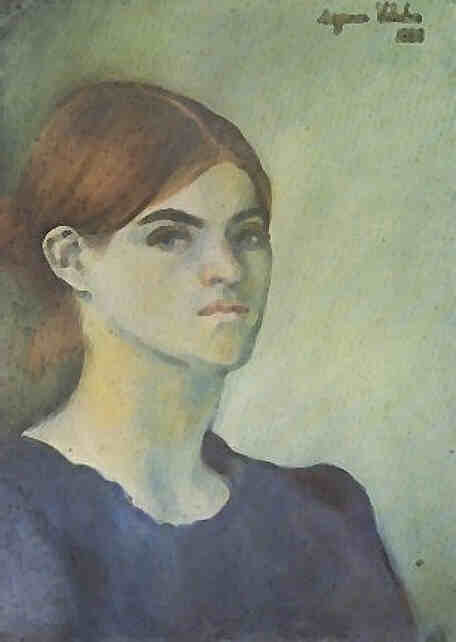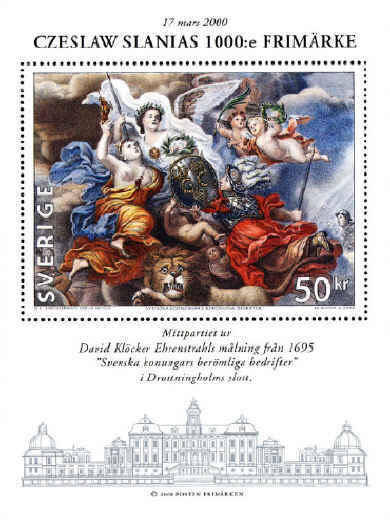^
Born on 23 September 1871: Frantisek
Kupka, Czech artist who died on 24 June 1957.
— He was one of the originators of abstract art. His early work showed
a preoccupation with expressive distortion and unusual, often unrealistic,
color. From 1911 to 1912, at the same time as the French painter Robert
Delaunay, Kupka painted his first completely abstract works, such as Amorpha:
Fugue in Two Colors (1912, Národní Galerie, Prague), consisting of colored
circular forms and lines in a rhythmic arrangement. He continued his experiments
in abstraction, grouping his work into five broad categories—Cycles, Verticals,
Verticals and Diagonals, Triangles, and Diagonals. Not as influential as
other abstract painters, Kupka did not receive deserved recognition until
after his death.
— School of Paris painter and wood-engraver; a pioneer of abstract
art. Born in Opocno in Eastern Bohemia. Apprenticed as a youth to a master
saddler, who initiated him in spiritualism; became a medium. Began to paint
and received his first instruction from Studnicka at Jaromer. Afterwards
studied at Prague Academy 1889-92 under the Nazarene painter Sequens and
at the Vienna Academy 1892-3 under Eisenmenger, also a Nazarene. Influenced
by Czech folk art, abstract ornamental patterning and Theosophy. Settled
in 1896 in Paris, where he worked first primarily as satirical draughtsman
for magazines such as L'Assiette au Beurre and as book illustrator. A friend
and neighbour of Jacques Villon from 1901, first in Montmartre, then from
1906 in Puteaux on the outskirts of Paris. His paintings influenced by Symbolism,
then Fauvism; experimented from 1909 with ways of rendering figures in motion
inspired by high-speed photography. From 1911 his work became abstract with
cosmic themes and rhythms, intersecting arabesques, rectilinear vertical
planes, etc. First Paris one-man exhibition at the Galerie Povolozky 1921.
Wrote a book on his theories, La Cr-23ation dans les Arts Plastiques (first
published 1923). Appointed professor by Prague Academy in 1922, to introduce
Czech students in Paris to French culture. Co-founder of Abstraction-Cr-23ation
1931, and adopted a more geometrical and classical abstract style. Died
in Puteaux.
— Kupka was born in Opocno in eastern Bohemia. From 1889 to 1892,
he studied at the Prague art academy. At this time, he painted historical
and patriotic themes. In 1892, Kupka enrolled at the Akademie der Bildenden
Künste, Vienna, where he concentrated on symbolic and allegorical subjects.
He exhibited at the Kunstverein, Vienna, in 1894. His involvement with theosophy
and Eastern philosophy dates from this period. By spring 1896, Kupka had
settled in Paris; there he attended the Académie Julian briefly and then
studied with Jean-Pierre Laurens at the Ecole des Beaux-Arts.
Kupka worked as an illustrator of books and
posters and, during his early years in Paris, became known for his satirical
drawings for newspapers and magazines. In 1906, he settled in Puteaux, a
suburb of Paris, and that same year exhibited for the first time at the
Salon d’Automne. Kupka was deeply impressed by the first Futurist manifesto,
published in 1909 in Le Figaro. Kupka’s work became increasingly
abstract about 1910–1911, reflecting his theories of motion, color, and
the relationship between music and painting. In 1911, he attended meetings
of the Puteaux group. In 1912, he exhibited at the Salon des Indépendants
in the Cubist room, although he did not wish to be identified with any movement.
Creation in the Plastic Arts, a
book Kupka completed in 1913, was published in Prague in 1923. In 1921,
his first solo show in Paris was held at Galerie Povolozky. In 1931, he
was a founding member of Abstraction-Création together with Jean
Arp, Albert
Gleizes, Jean
Hélion, Auguste Herbin, Theo
van Doesburg, and Georges
Vantongerloo. During the early 1950s, Kupka gained general recognition.
He died in Puteaux.
— LINKS
— Disks
of Newton, Study for Fugue in Two Colors (1912, 77x74cm) _ Kupka was
one of the most adventurous artists to follow the tradition, initiated by
the Impressionists and boldly continued by Matisse, of liberating color
from naturalist representation. This interest in freely interacting color
— together with a fascination with movement as revealed in photographic
investigations of animal and human motion — led Kupka to the creation of
dynamic abstract pictures like this one. The title refers to Isaac Netwon’s
discovery that natural light is made up of the colors of the spectrum, and
painters from Impressionism on believed that presenting these pure colors
on the canvas created a direct experience of light. Kukpa uses the full
range of hues — red, orange, yellow, green, blue, and violet, along with
white — to give a sense of the sun’s emanations in the expanse of the sky.
The circular forms in the painting overlap and interpenetrate each other,
producing an exciting feeling of movement and an image of cosmic space.
Larger meanings are suggested by the radiance of the picture, in accordance
with Kupka’s love of the effects of stained-glass windows in Gothic cathedrals,
whose glowing light provides spiritual associations. The fugue referred
to in the title further evokes spiritual experience, in particular the music
of Johann Sebastian Bach. In fugues, Kukpa wrote, “sounds evolve… intertwine,
come, and go,” and their sensuous, expressive, and intellectual richness
helped him progress to a completely abstract form of painting. In fact,
he declared, “I believe I can find something between sight and hearing and
I can produce a fugue in colors as Bach has done in music.” The ultimate
goal of his art, he said, is “to give us joy, a sense of beauty.”
— Money
(1899) — The
Wave (1902) —
Organization of Graphic Motifs II (1913) — Vertical
Planes
— (Plans
par couleurs, grand nu (1910, 150x181cm)
— The
Colored One (1920, 65x54cm) _ Although he moved to Paris at a young
age, Frantisek Kupka’s Bohemian origins, mysticism, and eccentric personality
kept him at a distance from the avant-garde circles of the artistic capital.
An individualist, he rejected association with any artistic school or trend,
but his paintings’ aggressive palette and dependence on color as a means
of faceting form and conveying meaning show undeniable affinities with Fauvism
and the work of Henri
Matisse, as well as with Orphism,
Robert
Delaunay’s color-based brand of Cubism.
A devoted mystic, Kupka spent his life in search of a transcendental other
reality, or “fourth dimension.” One of the first non-objective artists,
he extended his clairvoyant practice to his art as well, by uniting a metaphysical
investigation of the human body and nature with daring color and abstract
form.
Theosophy
— a quack pantheistic mishmash of pseudo-philosophy, pseudo-religion, and
pseudo-science — “guided” Kupka’s holistic approach to art.
His paintings draw on a variety of sources, including ancient myths, color
theory, and contemporary scientific developments. The invention of radiography
at the turn of the century was especially significant for Kupka, whose search
for an alternative dimension through a kind of painterly X-ray vision is
captured in his monumental Planes by Colors, Large Nude. In this
work, Kupka rendered the figure of his wife, Eugénie, in vivid shades of
purple, green, yellow, and blue, devising an innovative modeling technique
based on color, not line or shade, that sections her body into tonal planes
in such a way that her “inner form” is made visible. This unveiling of the
unseen is crucial, for Kupka believed that it is only through the senses,
through physical experience, that we can reach an extrasensory, metaphysical
dimension and thereafter achieve an intuitive understanding of the universal
scheme underlying existence.
Kupka painted The Colored One ten
years after Planes by Colors, Large Nude. By then he had adopted
a more boldly abstract mode of figural representation. (He would never abandon
subject matter altogether, however, unlike pure abstractionists such as
Piet Mondrian.) The Colored One also depicts a female nude, this
one lying on her back with legs stretched upward, cradling a radiant yellow
sun. Swirling forms outlined in concentrated colors convey the dominant
theme in Kupka’s work: the organic connections that intertwine human beings
with the rest of nature and the cosmos.
— Study
for Amorpha, Chromatique chaude and for Fugue à deux couleurs (1911,
47x48cm) _ Two of Frantisek Kupka’s earliest purely abstract compositions
are Amorpha, Warm Chromatic (1912) and Amorpha, Fugue in Two
Colors (1912). The present pastel study reveals an early stage in the
formal evolution of both of these paintings. In 1911 Kupka strove to eliminate
objective subject matter from his paintings. His development toward abstraction
is evident in his work of 1909 to 1911 in his interpretations of motion
and of the light and color of Gothic stained-glass windows. This pastel
relates to a series of studies that followed a naturalistic painting of
1908–1909 of his stepdaughter Andrée playing naked with a red-and-blue ball
in the garden of their home. More than fifty studies led Kupka from conventional
representation of this subject to the abstract formulations of the paintings
of 1912. In a note on one of the pencil drawings of Little Girl with
Ball, Kupka details his frustrations: “Here I am only dissecting surfaces.
The atmospheric copenetration is yet to be found. As long as there is a
distinction in color between ground and flesh, I will fall back into the
postcard photograph.”
In the present study, Kupka articulated the
girl’s motion by depicting the continuous penetration of the atmosphere
by the ball. A curving brown body shape guides the ball through the blue
path of its trajectory. This action occurs on a light green background plane,
which suggests the three-dimensional space of the garden. Such residue of
naturalistic color is abandoned in culminating versions of the study, such
as Amorpha, Fugue in Two Colors, which are conceived in blue, red,
black, and white. Kupka discerned a musical parallel to these abstract forms
in the rhythmic patterns of the fugue, “where the sounds evolve like veritable
physical entities, intertwine, come and go.” Kupka’s paintings of this period
are not simple or formulaic abstractions from ultimate “sources” in nature,
but are rather pictorial syntheses of the artist’s formal ideas. |



 —
‘Ehrenstrahl’ was an honorific title received on his ennoblement in Sweden
in 1674; his eventual appointment as court steward there in 1690 reflects
his status as a founding father of Swedish painting. He initially studied
in the Netherlands (1648–1650), but his early works, stylistically undecided,
reflect contemporary German painting. Such a work is his equestrian portrait
of Field Marshal Carl Gustaf Wrangel (1652), in whose service
he went to Sweden in 1651. In 1654 he went to study in Italy. In Rome
he learnt from Pietro da Cortona’s allegories and his mastery of compositional
devices, movement, color, light and shade. From there he went to Paris,
where he became acquainted with the work and career of Charles Le Brun.
When Klöcker returned to Sweden in 1661, the influence of Hedvig
Eleanora, the Queen Mother, secured him a position as a court painter.
—
‘Ehrenstrahl’ was an honorific title received on his ennoblement in Sweden
in 1674; his eventual appointment as court steward there in 1690 reflects
his status as a founding father of Swedish painting. He initially studied
in the Netherlands (1648–1650), but his early works, stylistically undecided,
reflect contemporary German painting. Such a work is his equestrian portrait
of Field Marshal Carl Gustaf Wrangel (1652), in whose service
he went to Sweden in 1651. In 1654 he went to study in Italy. In Rome
he learnt from Pietro da Cortona’s allegories and his mastery of compositional
devices, movement, color, light and shade. From there he went to Paris,
where he became acquainted with the work and career of Charles Le Brun.
When Klöcker returned to Sweden in 1661, the influence of Hedvig
Eleanora, the Queen Mother, secured him a position as a court painter.